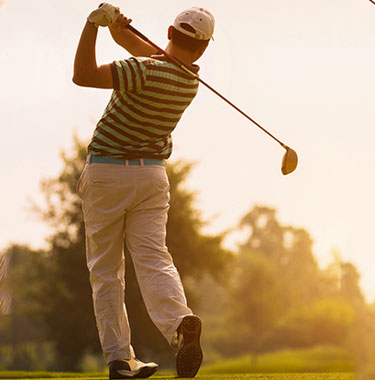MEDIAL EPICONDYLITIS “GOLFER’S ELBOW”

- Although less common than lateral elbow pain, medial epicondylitis or “golfer’s elbow” is a fairly common cause of medial elbow pain among athletes as well as in the occupational setting
- The muscles that flex our fingers, flex our wrist and pronate our forearm originate at the bony prominence along the inside of the elbow known as the medial epicondyle
- Activities that require repetitive wrist and forearm flexion can cause the common flexor tendons to pull on the medial epicondyle origin leading to inflammation and even small tears in the muscles and tendons
- Medial epicondylitis often does not occur in isolation and it is critical to address concomitant pathology
- Most commonly seen in patients between the ages of 35 and 50, but is much less common than lateral (outer) elbow pain associated with lateral epicondylitis
- In medial epicondylitis the pain is typically localized to the inner part of the elbow at the “knob” on the inside part of the elbow known as the medial epicondyle. Pain is worsened by repetitive gripping or lifting when the wrist and elbow are flexed. Pain will frequently radiate down the forearm
- Patients may describe weakness in flexion and grip strength
- Medial epicondylitis is frequently associated with overhead throwing, tennis, golf, bowling, weight lifting and football
SYMPTOMS:
DIAGNOSIS:
- Medial epicondylitis is typically a clinical diagnosis made by a thorough history and physical exam
- Pain is usually localized to the inner portion of the elbow and is tender to direct palpation over the medial epicondyle
- This pain can be worsened with resisted wrist flexion and resisted finger flexion with the arm pronated and elbow flexed to 90 degrees
- X-rays are typically normal but useful to evaluate the bony anatomy
- Ultrasound and MRI may be helpful to determine the severity of tendon tears and degeneration as well as rule out other ligamentous injuries such as an ulnar collateral ligament tear
TREATMENT:
- Before initial management, it is essential to discuss the natural history of epicondylitis and remember that the vast majority of cases are self-limited. However, it can take months for symptoms to completely resolve. Isolated medial epicondylitis rarely causes complications although it can be disabling
NON-SURGICAL
- Activity modification: The activity exacerbating the symptoms should be limited or modified. Avoidance of repetitive activities involving wrist flexion, forearm pronation and valgus stress of the elbow
- Medication: NSAIDS or Anti-inflammatory medications may help alleviate the pain
- Taping/Bracing: A counterforce brace, a band worn over the muscle of the forearm just below the elbow, can reduce the tension on the tendons. A wrist brace has also been shown to help reduce repetitive wrist flexion and reduce stress across the tendons. Kinesio Taping can also be an effective intervention
- Physical therapy: Stretching and/or strengthening exercises, ultrasound, or heat treatments may help the pain. See attachment of stretches from the AAOS
- Steroid injections: A steroid is a strong anti-inflammatory medication that can be injected into the area to reduce early inflammation
- Platelet-Rich Plasma (PRP) Injections: This includes withdrawing blood from an uninjured site and reinjecting it into the area of the medial epicondyle to induce a local healing response
Lateral Epicondylitis Stretches
SURGICAL TREATMENT:
- Operative management is typically reserved for chronic cases refractory to extensive nonoperative treatment for at least 6 months. Any concomitant pathology is also addressed at the time of surgery
OPEN DEBRIDEMENT:
- Operative techniques vary widely. Basic concepts of surgical management include resection/debridement of degenerative tissue with detachment and repair of the healthy common flexor tendon back to medial epicondyle origin
RECOVERY
- It is important to remember that even with surgical treatment of medial epicondylitis recovery is excepted to take several months and full recovery can take 6-12 months. Typical immediate postoperative period includes:
- Early elbow range of motion
- Wrist splint for 4 to 6 weeks with limited strengthening
- Physical therapy to reduce swelling and pain, and to regain motion and strength
- Avoidance of gripping activities greater than 3 pounds for 2-3 months

